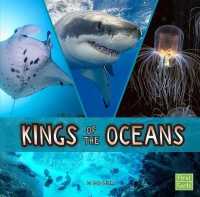- ホーム
- > 洋書
- > 英文書
- > Science / Mathematics
基本説明
Combines philosophical, societal, and artificial-intelligence concepts with those of computer science and informetion technology.
Full Description
"Intriguing . . . [filled with] new ideas about overarching intellectual themes that govern our technologies and our society."
—Nikil Jayant, Eminent Scholar, Georgia Research Alliance "Dr. Ahamed is correct in observing that 'silicon and glass have altered the rhythm of mind' and that computers need to be more 'human.'"
—Bishnu S. Atal, Member, National Academy of Engineering
This book combines philosophical, societal, and artificial intelligence concepts with those of computer science and information technology to demonstrate novel ways in which computers can simplify data mining on the Internet. It describes numerous innovative methods that go well beyond information retrieval to allow computers to accomplish such tasks as processing, classifying, prioritizing, and reconstituting knowledge.
The book is divided into five parts:
New knowledge sensing and filtering environments
Concept building and wisdom machines
General structure and theory of knowledge
Verb functions and noun objects
Humanistic and semi-human systems
This book offers new mathematical methodologies and concrete HW/SW/FW configurations for the IT specialist to help their corporations explore, exploit, compete, and win global market share.
Contents
Forword. Preface.
Introduction.
1 New Knowledge Environments.
Chapter Summary.
1.1 The Need to Know.
1.2 Role of Technology.
1.3 Knowledge and Wealth.
1.4 Evolving Knowledge Environments.
1.5 Structure and Communication of Knowledge.
1.6 Intelligent Internet and Knowledge Society.
1.7 Knowledge Networks.
1.8 Conclusions.
References.
2 Wisdom Machines.
Chapter Summary.
2.1 Many "Flavors" of Wisdom.
2.2 Three Orientations of Wisdom.
2.3 Optimization of Wise Choices.
2.4 Three-Level Functions.
2.5 Knowledge Machines Building Blocks.
2.6 Machine Clusters.
2.7 From Wisdom to Behavior.
2.8 Order, Awareness, and Search.
2.9 Conclusions.
References.
3 General Theory of Knowledge.
Chapter Summary.
3.1 A Basis for the Theory of Knowledge.
3.2 Comprehension, Nature, and Knowledge.
3.3 Central Processing and Knowledge Processing.
3.4 Accumulation of Information, Knowledge, and Wisdom.
3.5 The Enhanced Knowledge Trail.
3.6 Sequencing of Events at Nodes.
3.7 Transitions at I, K, and C Nodes.
3.8 Transition Management at Nodes.
3.9 An Inverse Universe.
3.10 Origin and Destination.
3.11 The Entropy of Knowledge.
3.12 Conclusions.
References.
4 Verb Functions and Noun Objects.
Chapter Summary.
4.1 Positive and Negative Social Forces.
4.2 Framework of Knowledge.
4.3 Compilation of Knowledge.
4.4 Derivation of Knowledge.
4.5 Knowledge Machine Software Hierarchy.
4.6 Knowledge Hardware and Software Systems.
4.7 Classical Migration Path of Knowledge.
4.8 Conclusions.
References.
5 Humanistic and Semi-Human Systems.
Chapter Summary.
5.1 Humanistic Chip Sets.
5.2 Essence of Human Activity.
5.3 Smart Verbs and Intelligent Nouns.
5.4 Algorithmic Representation.
5.5 Effects of Intelligent Response.
5.6 Gradation of Knowledge Processor Unit Responses.
5.7 Fragments of Overall Human Activity.
5.8 Dual Knowledge Processor Unit Human Interaction Model.
References.
A.1 Nonlinear Responses.
A.2 Oscillatory Response of Noun Objects.
B.1 Knowledge Machines for Human Interactive Processes.
B.2 Knowledge Machine for Labor-Management.
B.3 Knowledge Machine for Corporate Interactions.
6 Information and Knowledge Filters.
Chapter Summary.
6.1 Junk Information and Hype Knowledge.
6.2 Design of Conventional Signal Filters.
6.3 Signal Waves and Knowledge Flow.
6.4 The (I« »K) Filters.
6.5 The Design of (I« »K) Filters.
6.6 Configuration of (I« »K) Systems.
6.7 Selection of Noun Objects and Verb Functions in Samples.
6.8 Systems for (I« »K) Filters.
6.9 Two-Port Knowledge Network.
6.10 Knowledge Gates.
6.11 Contamination of (I« »K).
6.12 Decontamination of Knowledge.
6.13 Conclusions.
References.
7 Process and Change Of Entropy.
Chapter Summary.
7.1 Actions And Entropy.
7.2 Knowledge-Centric Objects.
7.3 Classification of Knowledge-Centric Objects.
7.4 Clusters of Complex Knowledge-Centric Objects.
7.5 Single-Process Kopcodes for Generic Knowledge-Centric Objects.
7.6 Multiple-Process Instructions.
7.7 Passive Kopcs.
7.8 Active Kopcs.
7.9 Execution of Multiple-Process Instructions.
7.10 Iterative and Reflexive Processing.
7.11 Macroinstructions For Knowledge Processor Units.
7.12 Knowledge Processor Unit Architectures for Kopc01-12 Instructions.
7.13 Conclusions.
References.
8 Knowledge System Architectures.
Chapter Summary.
8.1 From the Central Processor Unit to Knowledge Processor Unit.
8.2 The Philosophic Dimension.
8.3 Iterative Cyclic Social Processes.
8.4 The Scientific Dimension.
8.5 Varieties of Processors and Machines.
8.6 The Trend of Concepts.
8.7 Recent Trends Towards Wisdom.
8.8 The Trend of Values and Ethics.
8.9 Conclusions.
References.
9 Humans, Machines, and Networks.
Chapter Summary.
9.1 Ethics and Values In High-Tech Society.
9.2 Needs that Drive.
9.3 Networks that Transport.
9.4 Overlap of Needs and Networks.
9.5 Rationality of Humanistic Machines.
9.6 Wisdom Domain and Knowledge Rush.
9.7 Needs Pyramid of a Society.
9.8 Self-Perpetuating Power Loops.
9.9 Convergence of Knowledge and Motivation Hierarchies.
9.10 Knowledge Machines on Knowledge.
9.11 Conclusions.
References.
10 Architecture of Knowledge.
Chapter Summary.
10.1 A New Breed of Knowledge.
10.2 The Knowledge Loop and Its Stability.
10.3 Continuity of Knowledge.
10.4 Three Orientations of Wisdom.
10.5 Long-Term Movements within the K-Loop.
10.6 Conflictive Roles of TVB<>DAH Orientations.
10.7 Tracking of The K-Loops.
10.8 Details of Upward Migration.
10.9 Details of Downward Migration.
10.10 Knowledge Loops in X-And Y-Dimensions.
10.11 Four Ports of Super-Node K.
10.12 Construction of A Knowledge Plane.
10.13 Knowledge Bases in Primary K-Plane.
10.14 Successive K-Loops in the Time Dimension.
10.15 The Nebula of Knowledge: Knowbula.
10.16 Hindsight and Foresight.
10.17 Knowledge, Freedom, and Creativity.
10.18 Knowledge and Money.
10.19 Pinnacle of Mind and Infinity of Thought.
10.20 Social Migration and Political Agenda.
10.21 Conclusions.
References.
Acronyms.
Index.
Author Biography.








